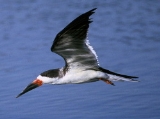
Skimmer
Encyclopedia
The Skimmers, Rynchopidae, are a small family of tern
-like bird
s in the order Charadriiformes, which also includes the wader
s, gull
s and auk
s. The family comprises three species found in South Asia
, Africa
, and the Americas
.
The three species are the only birds with distinctive uneven bills with the lower mandible longer than the upper. This remarkable adaptation allows them to fish in a unique way, flying low and fast over streams. Their lower mandible skims or slices over the water's surface ready to snap shut any small fish unable to dart clear. The skimmers are sometimes included within the gull family Laridae but separated in other treatments which consider them as a sister group of the tern
s. The Black Skimmer has an additional adaptation and is the only species of bird known to have slit-shaped pupils. Their bills fall within their field of binocular vision and enable them to carefully position their bill and capture prey. They are agile in flight and gather in large flocks along rivers and coastal sand banks.
They are tropical and subtropical species which lay 3-6 eggs on sandy beaches. The female incubates the eggs. Because of the species' restricted nesting habitat the three species are vulnerable to disturbance at their nesting sites. One species, the Indian Skimmer, is considered vulnerable
by the IUCN due to this as well as destruction and degradation of the lakes and rivers it uses for feeding.
The genus name Rynchops is often misspelled Rhynchops (as in some of the later editions of the works of Linnaeus
), though the first version is taxonomically valid, being Linnaeus's original spelling.
Tern
Terns are seabirds in the family Sternidae, previously considered a subfamily of the gull family Laridae . They form a lineage with the gulls and skimmers which in turn is related to skuas and auks...
-like bird
Bird
Birds are feathered, winged, bipedal, endothermic , egg-laying, vertebrate animals. Around 10,000 living species and 188 families makes them the most speciose class of tetrapod vertebrates. They inhabit ecosystems across the globe, from the Arctic to the Antarctic. Extant birds range in size from...
s in the order Charadriiformes, which also includes the wader
Wader
Waders, called shorebirds in North America , are members of the order Charadriiformes, excluding the more marine web-footed seabird groups. The latter are the skuas , gulls , terns , skimmers , and auks...
s, gull
Gull
Gulls are birds in the family Laridae. They are most closely related to the terns and only distantly related to auks, skimmers, and more distantly to the waders...
s and auk
Auk
An auk is a bird of the family Alcidae in the order Charadriiformes. Auks are superficially similar to penguins due to their black-and-white colours, their upright posture and some of their habits...
s. The family comprises three species found in South Asia
South Asia
South Asia, also known as Southern Asia, is the southern region of the Asian continent, which comprises the sub-Himalayan countries and, for some authorities , also includes the adjoining countries to the west and the east...
, Africa
Africa
Africa is the world's second largest and second most populous continent, after Asia. At about 30.2 million km² including adjacent islands, it covers 6% of the Earth's total surface area and 20.4% of the total land area...
, and the Americas
Americas
The Americas, or America , are lands in the Western hemisphere, also known as the New World. In English, the plural form the Americas is often used to refer to the landmasses of North America and South America with their associated islands and regions, while the singular form America is primarily...
.
The three species are the only birds with distinctive uneven bills with the lower mandible longer than the upper. This remarkable adaptation allows them to fish in a unique way, flying low and fast over streams. Their lower mandible skims or slices over the water's surface ready to snap shut any small fish unable to dart clear. The skimmers are sometimes included within the gull family Laridae but separated in other treatments which consider them as a sister group of the tern
Tern
Terns are seabirds in the family Sternidae, previously considered a subfamily of the gull family Laridae . They form a lineage with the gulls and skimmers which in turn is related to skuas and auks...
s. The Black Skimmer has an additional adaptation and is the only species of bird known to have slit-shaped pupils. Their bills fall within their field of binocular vision and enable them to carefully position their bill and capture prey. They are agile in flight and gather in large flocks along rivers and coastal sand banks.
They are tropical and subtropical species which lay 3-6 eggs on sandy beaches. The female incubates the eggs. Because of the species' restricted nesting habitat the three species are vulnerable to disturbance at their nesting sites. One species, the Indian Skimmer, is considered vulnerable
Vulnerable species
On 30 January 2010, the IUCN Red List of Threatened Species identified 9694 Vulnerable species, subspecies and varieties, stocks and sub-populations.-References:...
by the IUCN due to this as well as destruction and degradation of the lakes and rivers it uses for feeding.
The genus name Rynchops is often misspelled Rhynchops (as in some of the later editions of the works of Linnaeus
Carolus Linnaeus
Carl Linnaeus , also known after his ennoblement as , was a Swedish botanist, physician, and zoologist, who laid the foundations for the modern scheme of binomial nomenclature. He is known as the father of modern taxonomy, and is also considered one of the fathers of modern ecology...
), though the first version is taxonomically valid, being Linnaeus's original spelling.
External links
- Skimmer videos on the Internet Bird Collection

